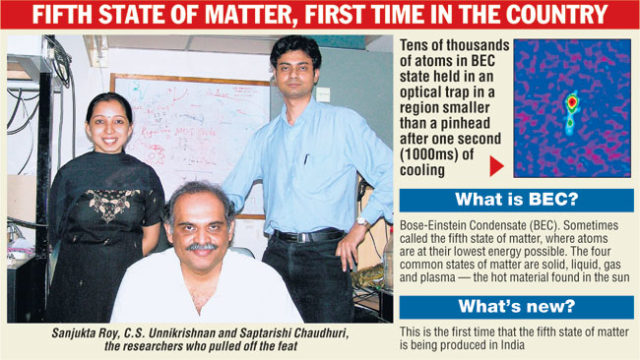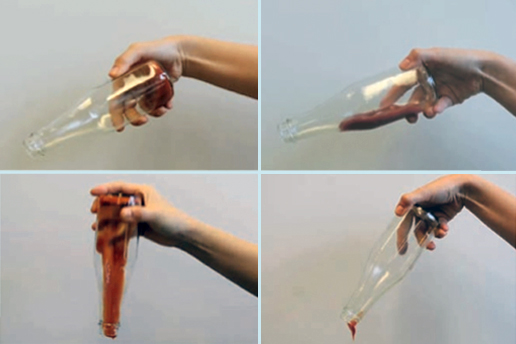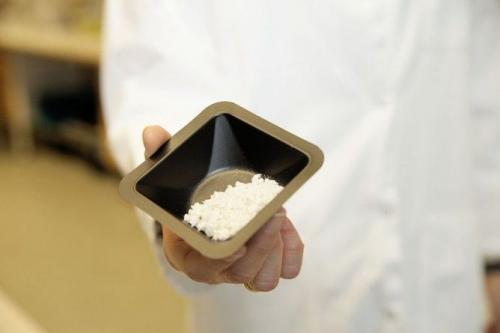Science is an ever-changing field that is constantly coming up with new ideas and advancements to make our lives easier. Some of these scientific advancements are mundane while others are a little too crazy to comprehend. This list compiles 10 of the craziest scientific advancements I’ve come across that I’m sure you can expect to see in the near future.
10. Electricity Conducting Cement
When it comes to good conductors, cement is usually not the first material you’d think of…until now. Scientists at the University of Alicante have recently developed cement that has the ability of conducting both heat and electricity efficiently and without compromising the strength that normal cement provides. While electricity conducting cement may not seem like a “mind-blowing scientific achievement” it has huge applications for places like airports and roads to prevent ice or snow build-up. Not only can the cement exist on its own, it can also be used as a coating on existing cement to give it heat and electric conductivity. The cement incorporates carbon nanotubes, which help give it the conductivity and strength it needs. While the material has proved successful in multiple tests, they are continuing to improve the material’s conductivity and strength.
9. Bose-Einstein Condensate
Satyendra Bose and Albert Einstein first hypothesized Bose-Einstein Condensates in the 1920s. With drastically improved facilities and techniques scientists have now been able to create and observe this completely new form of matter. In simple terms, Bose-Einstein Condensates are to extremely cold temperatures what plasma is to extremely hot temperatures. At these extreme temperatures, scientists have found that atoms begin to act in very odd ways. While no scientists have yet to achieve slowing particles down to absolute zero or the point at which there is no molecular motion, they have been able to generate the slowest and coldest temperatures in the known universe right here on Earth. It was during one of these “deep freezes” that particles were slowed to only billionths of a degree above absolute zero. Using the atom Rubidium, the scientists Cornell and Weiman discovered that atoms would clump together forming a “super atom”. All of the same properties are retained, BCEs take condensing to a whole new level by actually existing in the same place. It’s such an odd behavior that there is no known way of telling the atoms apart from eachother once they’ve formed the blob.
8. LiquiGlide
Ever had that irritating moment as you attempt to bang out the last bit of ketchup or shampoo stuck at the bottom of a bottle? Well not anymore thanks to a new non-stick material developed by researchers at MIT! LiquiGlide, as it’s called, is a nontoxic, nonstick, and insanely slippery coating that can have wide applications even outside the realm of condiments. While it’s not the first “superhydrophobic” material ever invented, it is the first non-toxic material approved by the FDA that is safe to use with food. By simply turning the bottle upside down, all of its contents smoothly slide out with no residue. Not only can it save companies money by eliminating the need for creating costly specialty caps and bottles, it also saves the frustration of banging the last bit of ketchup onto your plate. It works with both glass and specific kind of plastic. Companies are beginning to quickly take notice of the amazing material and it should be appearing in bottles very very soon.
7. Deep Voice Gas
We’ve all heard of helium gas that gives people high pitched voices, but have you ever heard of the gas that can make you sound like Darth Vader? Sulfur Hexafluoride is a man-made compound with some pretty interesting and unique abilities. Its abilities come from the fact that it’s an incredibly dense and heavy particle. Not only can you inhale it and suddenly become Barry White, you can float things on it and make them look like they’re levitating. Due to its weight, the speed of sound is slowed down considerably when trying to fight through the gas, causing your voice to deepen. Likewise, sulfur hexafluoride sinks to the bottom of a container when exposed to the air and has the density to cause things like tinfoil boats to float on it and look as if they’re floating in mid air. While sulfur hexafluoride has both fun and practical application, caution has to be taken when inhaling it because it could sink to the bottom of your lung and remain their if not exhales properly much like It would outside your body.
6. Upsalite
Imagine making the most absorbent substance known to man…by accident. Researchers at Uppsala University in Sweden accidentally left equipment running over the weekend causing the magnesium carbonate they were working with turn into a powder that has a surface area of 800m for just 1 gram of it. This extremely porous material is so absorbent, it’s referred to as an “impossible material”. The most expensive absorbent material used now, zeolite, doesn’t even hold a candle to its absorbency. It has massive implications for things like humidity control and large scale oil clean ups. The impressive material is surprisingly easy and inexpensive to make as well. The pores that little Upsalite’s surface are smaller than 10 nanometers, for those non-scientists a nanometer is on BILLIONTH of a meter. It goes to show that even little mistakes can end in great successes.
5. Nitinol
When asked to describe the properties of a metal memory and elasticity usually aren’t the two words that come to mind unless you’ve heard of nitinol. Nitinol is an alloy of nickel and titanium created in the Naval Ordnance Laboratory by William Buehler and Frederick Wang in 1958. Its properties exist at two phases, austenite and martensite. At low-temperatures (martensite) the alloy can be deformed and manipulated, but pops right back into shape at high-temperatures (austenite). This ability to miraculously pop right back into its parent shape is known as thermal shape memory. Along with its incredible memory, Nitinol is also known for its ability to be extremely useful in super springs because of its elasticity. The superelasticity works hand-in-hand with its thermal shape memory to snap it back into place. While Nitinol has received criticism for certain medical uses due to its nickel composition, it is very useful in applications where a lot of flexibility or movement is involved. While most metals are known to break after continuous bending, Nitinol has been proven to be nearly immune to breaking under this stress. Since its invention, it has been used in a variety of industrial and technological applications. The possibilities for this amazing material are continuing to grow as industries look for materials that can take a hit and keep on going.
4. Breathing Liquid
While it may seem like an idea right out of a science fiction movie, humans have the ability to breathe through liquids with the use of Perfluorocarbons. What makes Perfluorocarbons so special? Well, it’s their amazing capacitance, or ability to hold oxygen particles. While normal air has a capacitance of 30 times that of water, Perfluorocarbons have about 20 times the ability of water. Before you go and fill a pool with Perfluorocarbons for no reason other than to look cool and swim for hours, it does have some pretty cool uses practically and medically. Diving suits have been filled with it to mimic fish and prevent problems like nitrogen narcosis. It also have serves as a way to save the lives of premature babies or help those with respiratory problems. The uses for this amazing scientific invention are growing with seemingly no end in sight.
3. Self-Cleaning Clothes
No more cleaning clothes? Yep, scientists have finally developed a material to solve the problem of dirty laundry. Using only sunlight, the special cotton material breaks down not only dirt and residue, but toxic chemicals as well. A student at UC Davis has done this by embedding 2-anthraqunone carboxylic acid into cotton fabric by binding it to the cellulose. It works by breaking down the dirt in the fabric like peroxides do to the bacteria found in wounds. While the clothes are a bit more expensive, as anyone would expect self-cleaning clothes to be, researchers say that other chemicals similar to 2-AQC could work just as well and less expensively. Before you go sell your washing machine, you may not be seeing self-cleaning clothes on store shelves for quite a while. It’s inventors are looking towards more practical applications in places like the military or hospitals where clean closes are more vital and hard to come by than to the average Joe.
2. Oxygen Injection
David Blaine currently holds the world record for holding his breath an amazing 17 minutes, but thanks to a new oxygen injection, anyone could easily hold their breath for 17 minutes or longer without discomfort. Thanks to a breakthrough new oxygen particle invented by the Boston Children’s Hospital, humans can survived up to 30 minutes or more without taking a breath. What makes this particle so special is the fact that it’s surrounded by a fatty material, allowing it to be easily injected into the bloodstream. After injection, blood-oxygen levels can be returned to perfectly normal within just seconds. The particles are unlike any oxygen particles invented because they don’t cause bubbles (embolisms) upon injection. The particles deform to prevent this problem from occurring. The applications of the particle in medical world are endless. This miracle particle has the possibility of saving millions from those with respiratory failure to those who simply have trouble breathing.
1. Invisibility Cloak
Masking the appearance of someone with an invisibility cloak is one thing, but scientists have now figured out a way to mask time as well. How does this happen? Well Purdue scientists have found a way to manipulate the speed of light by speeding up the front of its wavelength and slowing down the end in optical fibers, so no one can perceive what you’re doing. It essentially creates a little “hole” in space-time where you can do basically anything you want without notice. The idea itself was mathematically proven as being possible in 2010 (not including the premiere of Harry Potter) and has since been successfully developed. While the cloak part itself doesn’t exist, scientists are intending to weave the optical fibers into a cloak like material. The material will have the ability to hide anything under it from everyone around you. The whole process occurs in 36 trillionths of a second and scientists are continuing to develop the technology.







2 Comments
This was a very interesting list.
That being said, you really need to get someone to proofread before posting these lists.
“apart from eachother once ”
“glass and specific kind of plastic.”
“remain their if not exhales properly”
“The pores that little Upsalite’s surface are smaller”
“It’s inventors are ”
“where clean closes are ”
“humans can survived up to”
That liquid breathing clip is from the movie “The Abyss”. Not exactly science fact.